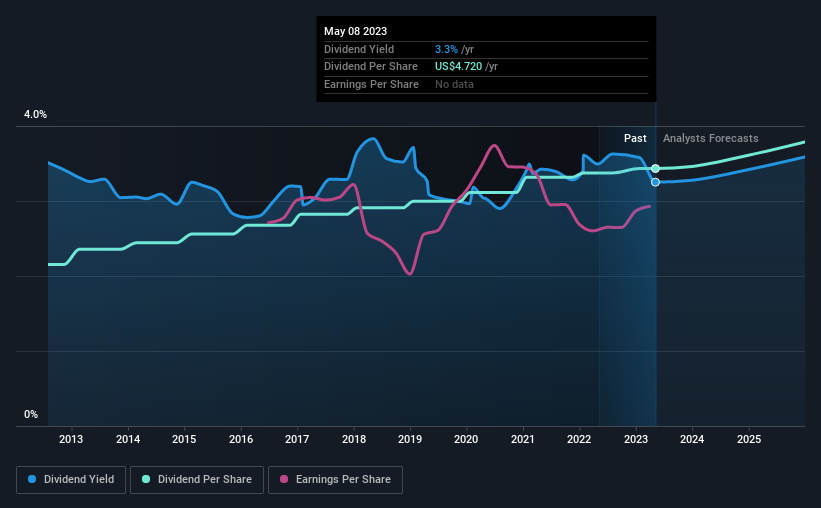- United States
- /
- Household Products
- /
- NYSE:KMB
Kimberly-Clark (NYSE:KMB) Is Paying Out A Larger Dividend Than Last Year

Kimberly-Clark Corporation (NYSE:KMB) has announced that it will be increasing its dividend from last year's comparable payment on the 5th of July to $1.18. This takes the dividend yield to 3.3%, which shareholders will be pleased with.
Check out our latest analysis for Kimberly-Clark
Kimberly-Clark's Dividend Is Well Covered By Earnings
A big dividend yield for a few years doesn't mean much if it can't be sustained. Before this announcement, Kimberly-Clark was paying out 80% of earnings, but a comparatively small 69% of free cash flows. Since the dividend is just paying out cash to shareholders, we care more about the cash payout ratio from which we can see plenty is being left over for reinvestment in the business.
Looking forward, earnings per share is forecast to rise by 28.2% over the next year. Under the assumption that the dividend will continue along recent trends, we think the payout ratio could be 65% which would be quite comfortable going to take the dividend forward.

Kimberly-Clark Has A Solid Track Record
The company has a sustained record of paying dividends with very little fluctuation. Since 2013, the annual payment back then was $2.96, compared to the most recent full-year payment of $4.72. This implies that the company grew its distributions at a yearly rate of about 4.8% over that duration. Slow and steady dividend growth might not sound that exciting, but dividends have been stable for ten years, which we think makes this a fairly attractive offer.
Dividend Growth May Be Hard To Achieve
Investors could be attracted to the stock based on the quality of its payment history. However, Kimberly-Clark has only grown its earnings per share at 2.7% per annum over the past five years. Slow growth and a high payout ratio could mean that Kimberly-Clark has maxed out the amount that it has been able to pay to shareholders. When the rate of return on reinvestment opportunities falls below a certain minimum level, companies often elect to pay a larger dividend instead. This is why many mature companies often have larger dividend yields.
Our Thoughts On Kimberly-Clark's Dividend
Overall, we always like to see the dividend being raised, but we don't think Kimberly-Clark will make a great income stock. The company has been bring in plenty of cash to cover the dividend, but we don't necessarily think that makes it a great dividend stock. We don't think Kimberly-Clark is a great stock to add to your portfolio if income is your focus.
Investors generally tend to favour companies with a consistent, stable dividend policy as opposed to those operating an irregular one. However, there are other things to consider for investors when analysing stock performance. For instance, we've picked out 2 warning signs for Kimberly-Clark that investors should take into consideration. If you are a dividend investor, you might also want to look at our curated list of high yield dividend stocks.
Valuation is complex, but we're here to simplify it.
Discover if Kimberly-Clark might be undervalued or overvalued with our detailed analysis, featuring fair value estimates, potential risks, dividends, insider trades, and its financial condition.
Access Free AnalysisHave feedback on this article? Concerned about the content? Get in touch with us directly. Alternatively, email editorial-team (at) simplywallst.com.
This article by Simply Wall St is general in nature. We provide commentary based on historical data and analyst forecasts only using an unbiased methodology and our articles are not intended to be financial advice. It does not constitute a recommendation to buy or sell any stock, and does not take account of your objectives, or your financial situation. We aim to bring you long-term focused analysis driven by fundamental data. Note that our analysis may not factor in the latest price-sensitive company announcements or qualitative material. Simply Wall St has no position in any stocks mentioned.
About NYSE:KMB
Kimberly-Clark
Manufactures and markets personal care products in the United States.
Undervalued established dividend payer.
Similar Companies
Market Insights
Community Narratives



